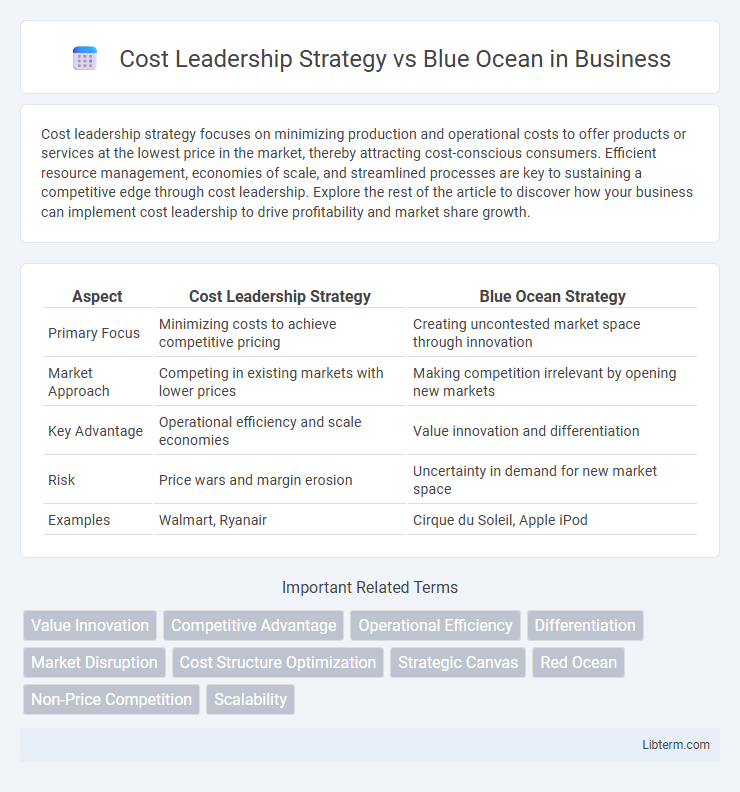Cost leadership strategy focuses on minimizing production and operational costs to offer products or services at the lowest price in the market, thereby attracting cost-conscious consumers. Efficient resource management, economies of scale, and streamlined processes are key to sustaining a competitive edge through cost leadership. Explore the rest of the article to discover how your business can implement cost leadership to drive profitability and market share growth.
Table of Comparison
| Aspect | Cost Leadership Strategy | Blue Ocean Strategy |
|---|---|---|
| Primary Focus | Minimizing costs to achieve competitive pricing | Creating uncontested market space through innovation |
| Market Approach | Competing in existing markets with lower prices | Making competition irrelevant by opening new markets |
| Key Advantage | Operational efficiency and scale economies | Value innovation and differentiation |
| Risk | Price wars and margin erosion | Uncertainty in demand for new market space |
| Examples | Walmart, Ryanair | Cirque du Soleil, Apple iPod |
Understanding Cost Leadership Strategy
Cost Leadership Strategy centers on achieving the lowest production and operational costs within an industry to offer competitive pricing and capture a broad market share. This strategy emphasizes efficient supply chain management, economies of scale, and rigorous cost control to sustain profitability despite reduced prices. Companies leveraging Cost Leadership often target price-sensitive customers while maintaining acceptable quality, differentiating from Blue Ocean Strategy, which seeks to create uncontested market space through innovation rather than competing solely on cost.
Defining the Blue Ocean Strategy
The Blue Ocean Strategy centers on creating uncontested market space by innovating value propositions, making competition irrelevant through differentiation and low cost simultaneously. Unlike Cost Leadership Strategy, which competes primarily on cost efficiency within existing markets, Blue Ocean Strategy seeks to unlock new demand by redefining market boundaries. This approach emphasizes strategic moves that combine innovation, utility, price, and cost to open up new growth opportunities beyond traditional competitors.
Core Principles of Cost Leadership
Cost Leadership Strategy focuses on achieving the lowest operational costs within an industry to offer products or services at competitive prices, primarily through economies of scale, efficient production, and tight cost control measures. It prioritizes standardized offerings and cost efficiency to attract price-sensitive customers, often leveraging supplier relationships and streamlined processes to minimize expenses. This approach contrasts with Blue Ocean Strategy, which emphasizes creating new market spaces by innovating and differentiating, rather than competing on price alone.
Key Elements of Blue Ocean Strategy
Blue Ocean Strategy centers on creating uncontested market space by innovating value in ways that render competition irrelevant, emphasizing differentiation and low cost simultaneously. Key elements include value innovation, which combines product differentiation and cost leadership to open new demand, and the Four Actions Framework, guiding firms to eliminate, reduce, raise, and create factors within the industry. The strategy encourages businesses to reconstruct market boundaries and focus on noncustomers, thereby unlocking new opportunities beyond traditional competitive landscapes.
Comparing Value Proposition
Cost Leadership Strategy emphasizes offering products or services at the lowest price point by achieving operational efficiencies and economies of scale, targeting highly competitive markets. Blue Ocean Strategy focuses on creating unique value innovations that unlock new demand in uncontested market spaces, prioritizing differentiation over cost reduction. The value proposition in Cost Leadership is centered on affordability and basic functionality, while Blue Ocean delivers exceptional, novel value that redefines customer experience and market boundaries.
Competitive Advantage: Cost vs. Innovation
Cost Leadership Strategy emphasizes gaining competitive advantage through minimizing production and operational costs, enabling businesses to offer lower prices than rivals. Blue Ocean Strategy focuses on creating uncontested market space by driving innovation and delivering unique value, making competition irrelevant. Companies leveraging cost leadership often compete on price efficiency, while Blue Ocean innovators prioritize differentiation through breakthrough products or services.
Market Focus: Existing Markets vs. New Markets
Cost Leadership Strategy targets existing markets by offering products or services at the lowest cost to gain competitive advantage and attract price-sensitive customers. Blue Ocean Strategy emphasizes creating new markets through innovation and value differentiation, making competition irrelevant by unlocking untapped demand. Market focus under cost leadership relies on competing within established industry boundaries, whereas blue ocean strategy seeks to redefine market space and explore uncontested opportunities.
Risk Factors and Challenges
Cost Leadership Strategy faces risks such as price wars, reduced profit margins, and vulnerability to cost fluctuations and technological changes, making it challenging to sustain competitive advantage. Blue Ocean Strategy involves pioneering uncontested market spaces, but it bears risks of market uncertainty, high innovation costs, and potential customer adoption barriers. Both strategies demand continuous monitoring of market dynamics and adaptable business models to mitigate inherent challenges and maintain long-term success.
Implementation Examples: Cost Leadership vs. Blue Ocean
Cost Leadership Strategy is exemplified by Walmart, which achieves competitive advantage through extensive supply chain optimization and economies of scale, delivering low prices to mass markets. In contrast, Blue Ocean Strategy is demonstrated by Cirque du Soleil, which redefined the entertainment industry by combining circus arts with theatrical storytelling, creating a new market space without direct competition. Implementation of Cost Leadership focuses on operational efficiency and cost reduction, while Blue Ocean prioritizes innovation and value creation to make competition irrelevant.
Choosing the Right Strategy for Your Business
Choosing the right strategy for your business depends on your industry landscape and competitive capabilities. Cost Leadership Strategy focuses on minimizing production costs to offer lower prices than competitors, ideal for highly competitive markets with price-sensitive customers. Blue Ocean Strategy emphasizes creating uncontested market space through innovation, targeting unmet needs to achieve rapid growth and avoid direct competition.
Cost Leadership Strategy Infographic

 libterm.com
libterm.com